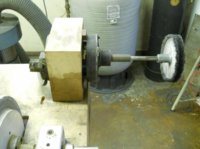I've had the HF 8" dual unit for many years, so many in fact that it's made in Taiwan. This was back in the days before they got all their stuff from China and before they had stores all over. I used to mail order from them. My unit doesn't have the extension on the grinding wheel side or I would have converted it to a dual buffer. I have mine mounted on the end of my work bench, with the buffer wheel side hanging out past the front of the bench. You can see it here on the left .....

When I got it, I wasn't much into buffing. I had none of the actual compound sticks and just used plain old automotive rubbing compound. It actually worked quite well. Spread a thin coat all over the piece and have at it on the wheel. I've since learned a lot more about buffing and did get the actual buffing compound bars. They tell you to use a different wheel for each compound so I figured another buffer was in order. I got the HF 6" unit. As mentioned, it's pretty weak compared to the 8" one. However, I'm using it for the medium and fine polishing so I don't stress it as much. My old 8" does the heavy work with coarse black compound.
Having a little welder is a wonderful thing. With it, I built a little portable (on wheels) stand for the 6" buffer. I made it large enough to also hold a 6" grinder I had laying around unmounted .....
Both units are wired into a junction box and run off the same power cord .....
The wire wheel set-up clamped to the lower shelf is another really portable contraption I whipped up. It's an old furnace blower motor (I think) with an adapter on the shaft so it can take grinding/buffing/wire wheels. It's mounted to a piece of 2" x 12" with an on/off switch. I take it with me when going to work on guy's bikes and use it mostly for cleaning up the ratty threads on their nasty looking bolts.
 Thanks
Thanks Thanks
Thanks

